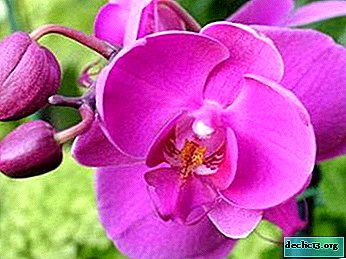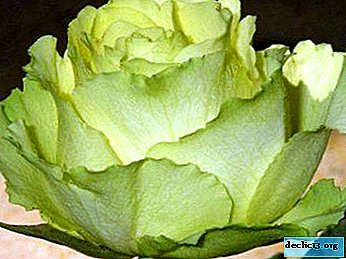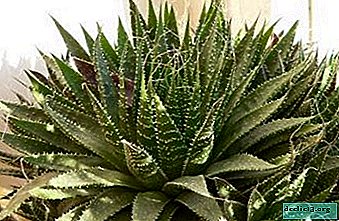Florists on whether it is possible to transplant an orchid in the fall

Orchid is a durable and unpretentious representative of the hot tropics. For its successful cultivation, you need to create comfortable conditions.
Each owner of this beautiful flower sooner or later wonders how to transplant an orchid. But it is equally important to know when to do it. With the right approach, this will benefit the plant. You will find answers to all these questions in this article. And also learn how to prepare the plant for a period of rest.
Plant Life Cycle in September, October and November
Reference. Autumn is a transition period for this plant. Despite the fact that at this time orchids are preparing for wintering, some of them also bloom.In September, the sun is not as hot as in summer, because the flowers that were put on the balcony or in the garden for this period should be returned home. After that plants must be carefully inspected for pestsotherwise, from one flower the others may then become infected.
Also, from this month the amount of fertilizers applied is gradually reduced. They also lower the temperature at night from 14 to 24 degrees, depending on the variety. Thus, the orchid is prepared for winter.
 In October, some species of this plant prepare for the flowering period, while others “fall asleep” for the winter, partially dropping the foliage. You should not worry about such changes - you just need to examine the orchid and, if no other signs of the disease are found, then leave the flower to winter.
In October, some species of this plant prepare for the flowering period, while others “fall asleep” for the winter, partially dropping the foliage. You should not worry about such changes - you just need to examine the orchid and, if no other signs of the disease are found, then leave the flower to winter.
In November, these flowers are least in need of fertilizing and watering. There are exceptions, such as phalaenopsis - care for this species is the same as at other times of the year, because they do not have a rest period. But in any case, it is necessary to consider heating systems, which include at this time - now orchids need more intensive watering.
Due to the short daylight hours, you should also install special lamps for orchids so that they do not suffer from a lack of light.
Is it possible to transplant at this time of the year?
The best time for a flower transplant is the period of its rest. Usually it falls in September-October in the fall and in April in the spring.
In autumn, the orchid becomes “sleepy” and for a more comfortable wintering, it will need a fresh substrate. In the spring, on the contrary, it will be a good help, because the plant takes from it useful substances for itself.
Important! Sometimes an orchid transplant during flowering favorably affects the plant. This condition is strictly individual for each flower.At what time of the year and period it is better to transplant an orchid into a pot at home, you can find out here, and in this article we talked about whether it is possible to transplant a plant if it starts the arrow.
Which way to choose?
- Along with the common method of transplanting orchids into another pot, there is another one - planting on a block. In this case, the roots are wound to the block with a thin fishing line. In order for them to dry out less, they use moss - they cover their roots, and also cover the block itself.
- The second method is closer to the natural conditions in which orchids grow in the wild. Only in order for the plant to feel comfortable, it is necessary to provide it with the usual tropical humidity. Therefore, if it was a pleasant decision to move the flower to a block, then it will be necessary to keep it in greenhouses with high humidity.
- You also need to highlight the transshipment method. In this case, the orchid is transplanted into a new pot with old soil, adding fresh only at the edges. This method is the least traumatic for the plant and is suitable if it is only necessary to increase the volume of the pot without refreshing the substrate.
- For apartments, a familiar transplant or transshipment into a pot is more suitable, which will protect the orchid's roots from drying out. The flowerpot itself prevents the quick drying out of the root system, making it gradual, and the content of the flower on the block does not give such protection - the roots dry very quickly with normal humidity in the apartment.
Pot and soil selection
So that the flower after transplanting grows well, it is necessary to choose the right substrate and pot.
 Now there are many different flower pots that can be suitable for orchids, but any of them must meet certain requirements that ensure:
Now there are many different flower pots that can be suitable for orchids, but any of them must meet certain requirements that ensure:
- Outflow of moisture so that the roots do not rot.
- Air circulation inside the pot.
- Safe extraction of rhizomes that sometimes creep out of the pot.
- Optimum temperature conditions.
Orchid does not require large flowerpots, the main thing is that they are made for the needs of this flower. To do this, the pot should have holes for drainage, the height of the container should be equal to the width of the neck, and the volume should be suitable for the root system (it should fit freely in it). Also the pot should be transparent, because the roots of orchids are actively involved in photosynthesis.
Recommendation. It is better to refuse glass pots because glass can injure a plant.Soil should also meet the needs, therefore it is better to purchase it in flower shops. If you want to do it yourself, you need to familiarize yourself with the composition:
- Pine bark.
- Moss Sphagnum.
- Fern root
- Charcoal.
- Broken walnut shell.
- Expanded clay.
The substrate from the store must be subjected to disinfection (boiling) and sifting.
Plant preparation
To do everything right, you need to prepare a flower and everything you need. Choose a pot should be 2 cm more than the current one. Clippers or a sharp knife - these items are sanitized before use. A bamboo stick to support the flower (you can use other material) and a substrate for orchids.
Step-by-step instructions for home use
When all this is prepared, you can proceed to transplantation. It is important not to rush anywhere and do everything carefully so as not to harm the plant.
Pot extraction
First, you should stretch the pot so that you can easily pull out the flower. If the contents have completely dried up (this happens if you start the orchid), then you need to lower the pot for an hour in warm water. After that, getting a plant is not difficult.
You can also cut the pot, if the roots are excessively attached to the walls. This should be done carefully so as not to damage them.
Flushing
After removing the root lump, you need to spread it with your hands. Thus, cleansing of the lumps of the substrate will occur. Next, you can rinse the entangled roots under warm water to wash away the soil.
Pruning roots and leaves
After the plant is cleaned, dead elements of the roots should be removed. This is done with sharp scissors or a knife. Only bad roots need to be removed - hollow, sluggish, rotten. The same must be done with the dying leaves. Slicing areas are treated with charcoal.
Important! If pests are found on the roots, the orchid must be left for an hour in a bucket of water - the parasites will quickly die.Here is how to cut orchid roots during transplantation and to avoid damage to the flower.
Capacity preparation
A transparent pot with ventilation holes is filled one quarter with a substrate. The bottom is laid with drainage material (pebbles, expanded clay). This is necessary so that the roots of the flower are not damaged by excessive moisture.
More information on how to choose a pot for transplanting orchids at home is described in our article.
The room in the new "house"
 Before arranging the plant in a new container, it is necessary to dry it. To do this, the orchid just needs to leave the orchid at room temperature without soil and water for two hours.
Before arranging the plant in a new container, it is necessary to dry it. To do this, the orchid just needs to leave the orchid at room temperature without soil and water for two hours.
After that, carefully place the flower in a new pot. Then gradually add the substrate, distributing it with a thin stick, so that there is no free space between the roots. To make the soil more dense, you should tap on the walls of the pot.
In no case should you push and try to push more substrate into the pot. This can easily damage the roots of the orchid.
If some too long rhizomes do not fit into the pot, then it is better to leave them outside. Thus, the orchid will use them to collect additional moisture from the air.
First watering
After a transplant, the orchid needs peace, because in the first five days it is not recommended to water it. Such a break is also due to the fact that the plant needs time to heal the wounds from the slices that were obtained by removing obsolete material. Instead of watering, spray the leaves so that the flower does not begin to dry.
Reference. Fertilizers must be applied only 3-4 weeks after transplantation.Will bloom and how soon?
If the orchid has not bloomed for a long time (more than three months in a row), then a transplant can provoke this process. Usually, after such resuscitation, the plant does not give an arrow immediately, the reason for this is stress. The orchid is very sensitive and the transplant can affect the appearance of the plant until the leaves turn yellow. But this happens mainly in violation of safety rules. If done correctly, the orchid may well bloom after some time.
Possible problems and difficulties
You can make the mistake of transplanting from inexperience, which greatly undermines the health of orchids. Here are the most common ones:
- Wrong pot selection.
- Poor substrate or improperly prepared.
- Fuzzy following transplant instructions.
- Transplanting during flowering without special need.
A problem may arise if an orchid is transplanted after purchase without removing the sphagnum - in this case, the roots rot and die.
If everything is done correctly, then there will be no negative consequences for the flower.
Follow-up care
After transplanting, the plant needs special care: partial shade and lack of watering. In such conditions, the orchid should spend 3-4 days, for which it adapts to the new pot. At this time, it is necessary to carefully monitor its condition.
If the plant does not grow for a long time after transplantation, then you should increase the air humidity, bringing the conditions closer to natural for it. This is done simply - the pot with the flower is placed in a plastic bag. The air is humidified using a spray, but without dropping water on the plant itself. In the process of spraying, airing also occurs. They keep the orchid in this state until it begins to grow.
Fulfilling all the conditions for transplantation, you can avoid many problems that often lead to the death of the plant. Therefore, it is very important to be careful and be careful - the more carefully the transplant process takes place, the less stress the orchid will receive.
Useful video
Watch the video on how to transplant Phalaenopsis Orchid:

















